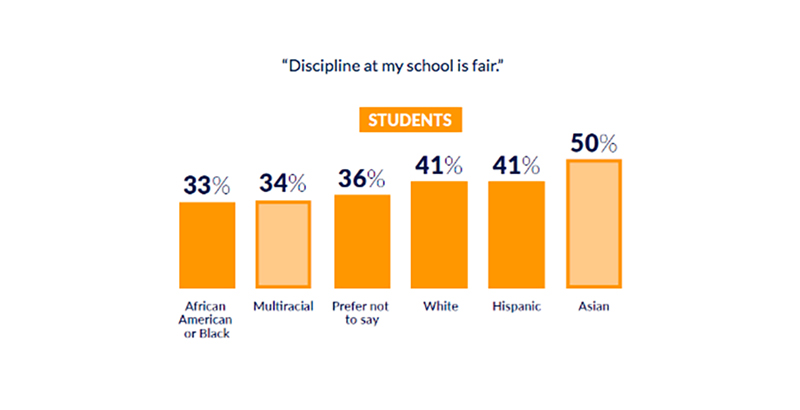Simpson: How Do We Know if School Discipline Is Fair? Listen to Student Voices — 60% of Kids Think It Isn’t

The past decade of federal, state and local advocacy aimed at improving school discipline outcomes is encouraging. Some studies show rates of suspensions in decline, and the list of resources available to help educators rethink discipline policies is lengthening. Yet recent federal civil rights data suggest there’s still a lot of work to do. According to a 2018 report from the Government Accountability Office, black students make up around 15 percent of all public school students but constitute close to 40 percent of all suspensions.
The nonprofit I work for, YouthTruth, helps schools measure nonacademic indicators related to school climate and academic achievement. We wanted to know: What do students, parents/guardians and school staff think about discipline and fairness in their schools?
To answer this question, we analyzed the survey responses of more than 104,000 students, parents/guardians, and instructional and noninstructional school staff members across 132 secondary schools. Here are some key things we learned (click here to read the full report):
1. Overall, students feel less positively about discipline than do families or staff. Less than half of students – 40 percent – feel that discipline at their school is fair, compared with 59 percent of family members and 50 percent of staff.
2. Stakeholders at high-poverty schools have similar experiences with discipline as do those at other schools. This is true when analyzing experiences with discipline across stakeholders at high-poverty schools — those in which at least 70 percent of students receive free or reduced-price lunch – versus other schools, as well as based on a student’s free or reduced-price lunch eligibility, regardless of the school’s overall poverty level.
3. Students, families and staff of different races and ethnicities have different experiences with discipline and fairness. Asian students rate discipline at their school more positively than do other racial or ethnic groups, while multiracial students rate discipline at their school less positively. (African-American or black students’ ratings are a few percentage points lower than other students’ ratings, but the difference is not statistically meaningful.) For families, Hispanic and Asian parents/guardians rate school discipline more positively than do other groups, while white family members and those who preferred not to identify their race or ethnicity feel less positively. For staff, those who preferred not to disclose their race or ethnicity also feel less positively.
4. In our analysis, if one group of school stakeholders feels positively about discipline, other stakeholder groups in that school tend to agree. Looking at the top 25 percent of schools in which students felt the most positively about discipline, 69 percent of those schools were rated as “above typical” in the eyes of parents and guardians (“above typical” means a school was in the top half of schools in our sample based on family members’ ratings of discipline). Results for staff were similar to those of family members.
5. High school students and families feel less positively about discipline than do middle school students and families. Middle school students rate school discipline 10 percentage points more positively than do high school students: 45 percent, compared with 35 percent. Similarly, 63 percent of middle school families rate the fairness of discipline positively, while only 55 percent of high school family members say the same.
Our findings show that knowing how one group feels about discipline can help education leaders gauge how other groups feel. Yet analyzing multi-stakeholder feedback shows that some factors appear to impact individuals’ experiences with school discipline more than others. For example, while family income has no meaningful effect on students’ and families’ responses, race/ethnicity and grade level influence student, family and staff in nuanced ways. In other words, it’s not enough to just hear from one group, and while families have a unique perspective depending on their vantage point, that perspective can’t substitute for hearing from students and staff.
Federal and state policies leave a lot of room for discretion and decision-making by schools and districts, so it’s important for educators to reliably know whether school discipline policies and practices are working, and for whom. With Education Secretary Betsy DeVos’s rollback of discipline guidelines designed to protect students of color last December, it’s especially important for educators to constantly reflect on personal biases and the harmful results of disproportionately applied discipline based on student demographics.
Research shows just how dangerous it can be when inconsistency can slip into school discipline policy. When managed poorly, discipline can have serious short- and long-term effects not only on learning but also on students’ lives inside and outside of school, including contributing to the school-to-prison pipeline. Supportive and positive systems of discipline, however, can radically improve social, emotional and academic outcomes for students. They help students find a sense of belonging, and they invite them to discover how capable they are and use their personal power in constructive ways.
These findings exemplify the kinds of insights that can be gleaned when we ask school stakeholders directly about their experiences. Data like these spark conversations. They help districts ask the right questions about the why, and to know how and where to target improvements. Feedback also keeps schools and districts accountable to their goals over time.
Understanding how students, family and staff experience school discipline is a powerful way to know whether policies and practices are working, and for whom. We only need to ask: Is discipline fair at this school?
Jimmy Simpson is partnerships lead and equity coach for YouthTruth, a national nonprofit that harnesses student perceptions to help K-12 educators accelerate improvements in their schools and classrooms.
Get stories like these delivered straight to your inbox. Sign up for The 74 Newsletter

;)